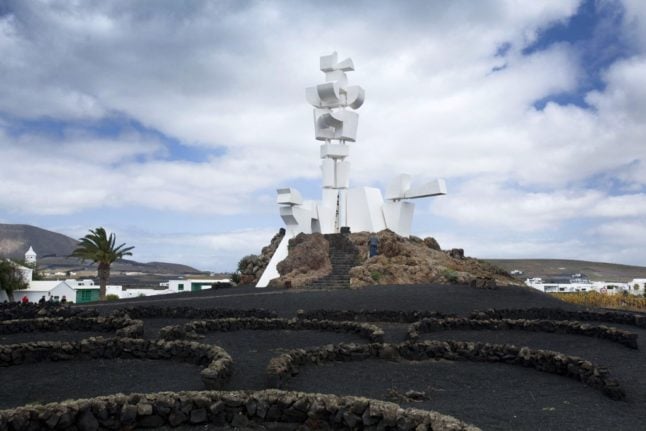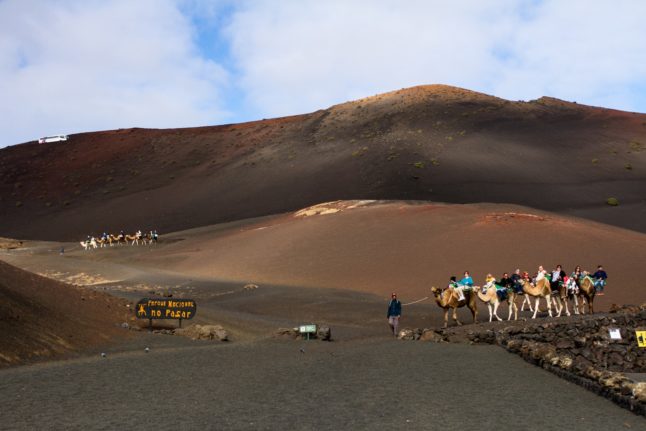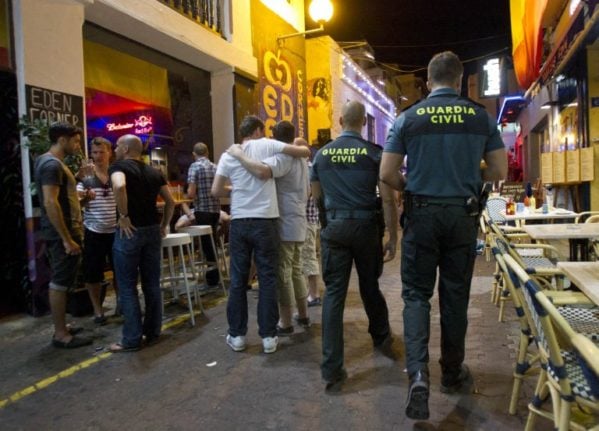One of Spain’s seven main Canary Islands, Lanzarote is loved by international tourists for its dramatic volcanic landscapes, beautiful sandy beaches, diverse natural attractions and great year-round climate. But this has come at a price.
In early February, the Island Council declared itself a “tourist-saturated area”, something for which they assure there is “a broad social consensus”.
During a press conference at Madrid’s annual tourism fair – FITUR, in January, María Dolores Corujo, president of the Cabildo of Lanzarote, the island’s government office, said that the island is aspiring to receive fewer tourists, “with greater spending in the destination so that they can generate greater wealth in the economy as a whole”.
According to Corujo, the difficulty the island faces in doing this is that more than half of the island’s visitors come from the United Kingdom, so it would be necessary to create “a diversification strategy to reduce dependence on the British market”.
Lanzarote’s leader explained that the reduction in the number of visitors to the island is necessary “to guarantee the future of coming generations”.
But her statements have been taken out of context with many UK tabloids saying that she wants to limit or ditch British tourists specifically rather than reducing the island’s dependence on them.
The Daily Mail wrote: “Lanzarote says it is fed up with having so many British tourists visiting the island – and wants FEWER UK holidaymakers”, while The Sun went with “Isle Be Off – Spanish holiday island will limit British tourists – despite fuming locals”. The Express wrote: “Lanzarote to limit tourists as locals fume at ‘uncivil behaviour’ and ‘too many people'”.
When Corujo attended the Berlin Tourism Fair in early March in a bid to promote a more sustainable tourism model for her island, she was quoted as saying: “It is essential to work on the diversification of our tourism sector and the growth of markets such as Germany, which are in line with our intentions to bet on higher quality tourism and higher spending at the destination, to the detriment of mass tourism”.
The British tabloids again went with headlines such as “Lanzarote’s president heaps praise on German tourists as the island looks to attract ‘higher-quality’ holidaymakers and rely less on Brits” by The Sun.
These hyperbolic headlines misconstrue reality and are yet another attempt to perpetuate the British expat myth of ‘they need us more than we need them’.
Lanzarote authorities have not explicitly said that the island doesn’t want British tourists, they simply want to change the tourism model (and have done for some years) to a higher-spending holidaymaker whose primary interests are enjoying untouched nature and high-quality services rather than cheap holiday package deals at crowded resorts.
In response to the articles in the British press, Héctor Pulido, vice president of the Association of Hotel and Apartment Entrepreneurs of Lanzarote (Asolan) admitted that Corujo’s words had caused “confusion” but that “these are statements that are not directed at the British market”.
“Our job now is that Lanzarote continues to be valued positively and we receive all those who want to visit us with open arms”, he clarified.
According to the latest statistics, the island has a population of just 151,000 conejeros, as the locals are called.
In 2022, however, Lanzarote received a total of 2.8 million visitors, which is around 17 times its population.
This far exceeded the 1.2 million tourists that arrived in 2021, which was still feeling the effects of the pandemic.
British tourists currently make up around half the number of visitors to the island. The latest figures show that Brits spend less than most of their Northern European counterparts, as evidenced by the reaction of one of the “furious British holidaymakers hitting back at Lanzarote’s president”.
“We only came here on holiday because it was cheap. We paid £250 for flights and a week’s accommodation,” Caitlin, a 23-year-old postgraduate, told the Daily Mail.
“These statements annoy those who continue to think that more development is the same as more beds and have sown fear with a non-existent alarm in the British market,” Corujo said in reaction.
“However, we have never heard them talk about the negative impact of the Papagayo Arena or the skeletons of Costa Teguise, which do deteriorate our image as a destination,” she added, defending her position and her statements.
Papagayo Arena is a huge all-inclusive hotel taking up much of Playa Blanca, while the Costa Teguise is another resort area filled with water parks and surrounded by golf courses.

Lanzarote, an island with a legacy
Tourism on Lanzarote has always been a bit different from that of neighbouring Gran Canaria and Tenerife, where mass tourism and overdevelopment have been allowed to grow more uncontrollably.
For example, roadside billboards and high-rise hotels are banned on Lanzarote. Apart from a few places on the island, it is certainly not the ‘Lanzagrotty’ that for the years the British press has portrayed it as being.
This is partly down to César Manrique, a visionary artist, sculptor and nature activist born in 1922 in Arrecife, Lanzarote’s capital.
After working in New York, Manrique returned to his island in 1966, building a series of original buildings that merged with the island’s unique landscape and have become part of its attraction.
He also worked closely with the local government on regulations that protected Lanzarote from the ravages of rampant development and encouraged sustainable tourism.
READ ALSO: The man who saved Lanzarote from overdevelopment
Thanks to Manrique’s influence and legacy, the island has for the most part avoided the same fate as the concrete jungles in some resorts in Spain’s other popular tourist spots like the Costa Blanca or the Costa del Sol.
Lanzarote has managed to position itself as an attractive destination committed to the environment and has enjoyed over 100 years of sustainability (as highlighted by National Geographic) and wants to keep it that way.

Spain’s other tourism hotspots face the same dilemma…and bad press in the UK
This is not the first time that the UK tabloids have blown statements about Spanish tourism out of proportion and taken what leaders have said way out of context in order to trigger anger and clicks among their target audience.
For example, in July 2022 many outlets reported that British tourists will now have to prove that they have €100 to holiday in Spain, but this also turned out to be not entirely true.
Recently many UK media outlets also reported that the city of Barcelona wants to limit the number of tourists to the city. However, Barcelona mayor Ada Colau simply said that the city had reached its limit and has not placed any caps on numbers.
What is true though is that many Spanish destinations are suffering from over tourism and numbers have quickly bounced back after the pandemic. Lanzarote is not the only Spanish destination aiming to reduce its number of tourists.
Regions across Spain have introduced restrictions for some of its most popular natural attractions, in a bid to stop overcrowding and promote sustainable tourism. This is true for national and natural parks in Andalusia, Aragón, Asturias, the Balearic Islands, the Canary Islands, Valencia and Castilla-La Mancha, among others.
READ ALSO: How Spain is imposing caps on visitor numbers for its top attractions
In February 2023, the government of the Balearics said that they want to put a cap on the number of visitors to the holiday islands and only allow 16.5 million per year. This is all part of the regional government’s plan to remodel its tourism industry, which will also focus on reducing the number of tourists in summer and trying to attract more during other times of the year.
In 2020, there were already talks about Mallorca cutting back on cheap boozy tourism and shifting to a different model.
The regional parliament of Spain’s Balearic Islands also recently approved a law that allowed the island of Menorca to limit the number of cars that can visit, preventing it from becoming choked by fumes and overrun during summer months.
While Barcelona hasn’t put a cap on visitor numbers yet, it has banned the building of new hotels, trying to limit the number of cruise ships and is increasing the tourist tax in order to try and keep numbers down.



 Please whitelist us to continue reading.
Please whitelist us to continue reading.
Member comments